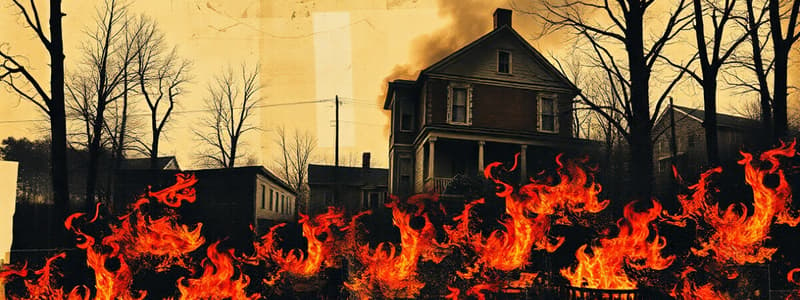Podcast
Questions and Answers
During an interior fire scene examination, what is the primary rationale for progressing from areas of least fire damage to areas of heaviest damage?
During an interior fire scene examination, what is the primary rationale for progressing from areas of least fire damage to areas of heaviest damage?
- To prioritize the collection of evidence that is least likely to be contaminated or destroyed.
- To ensure the structural integrity of the building before entering more damaged areas.
- To systematically document the increasing intensity of the fire's effects, aiding in identifying the fire's origin. (correct)
- To minimize exposure to potential hazards such as falling debris in severely damaged areas.
What is the significance of identifying multiple points of origin during a fire scene examination?
What is the significance of identifying multiple points of origin during a fire scene examination?
- It may indicate the fire was intentionally set (arson). (correct)
- It confirms the fire was accidental due to multiple ignition sources being present.
- It simplifies the investigation process by providing multiple areas to focus on simultaneously.
- It suggests a rapid fire spread, indicating the presence of accelerants.
Why is the identification of fire patterns, heat patterns, and smoke patterns important during a fire scene examination?
Why is the identification of fire patterns, heat patterns, and smoke patterns important during a fire scene examination?
- They offer insights into the fire's behavior and spread, which is essential to help evaluate the point of origin. (correct)
- They help to determine the cost of damages, helping to determine the insurance liability.
- They provide information about the types of materials that were burning, helping to determine the fuel load.
- They allow investigators to accurately determine the timeline of the fire, from ignition to extinguishment.
What should an investigator do after identifying fire characteristics, heat patterns, and smoke patterns at a fire scene?
What should an investigator do after identifying fire characteristics, heat patterns, and smoke patterns at a fire scene?
During the physical examination of a fire scene's interior, which of the following actions is LEAST likely to be performed when progressing from areas of light damage to areas of heavy damage?
During the physical examination of a fire scene's interior, which of the following actions is LEAST likely to be performed when progressing from areas of light damage to areas of heavy damage?
Flashcards
Interior Fire Scene Examination
Interior Fire Scene Examination
Examination progresses from areas with the least fire damage to the heaviest, to identify the area(s) of fire origin.
Fire Characteristics
Fire Characteristics
Fire characteristics are heat and smoke patterns used to evaluate the point of origin.
Multiple Fire Origins
Multiple Fire Origins
Multiple points of origin may suggest intentional ignition.
Study Notes
- Physical examination of a fire scene's interior starts from areas with the least fire damage and progresses towards the heaviest damage.
- The aim is to pinpoint the area(s) where the fire originated.
- Examination includes identifying fire characteristics, heat, and smoke patterns to better assess the origin point.
- Multiple points of origin should be noted, as this could be an indicator of arson.
Studying That Suits You
Use AI to generate personalized quizzes and flashcards to suit your learning preferences.




